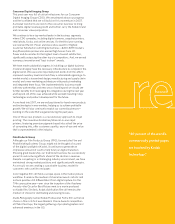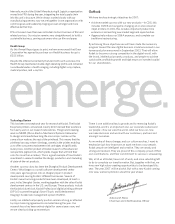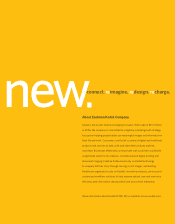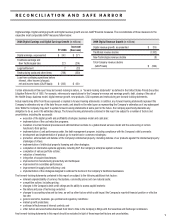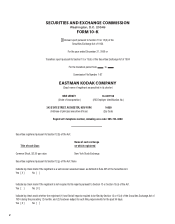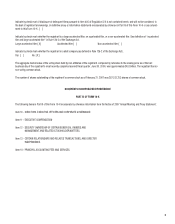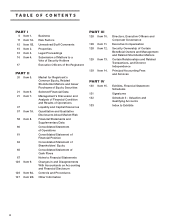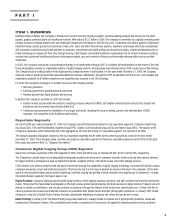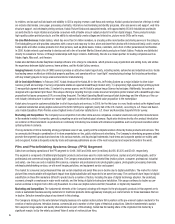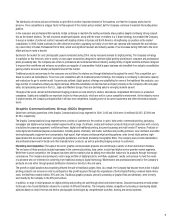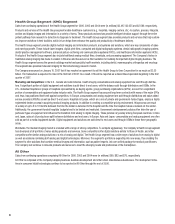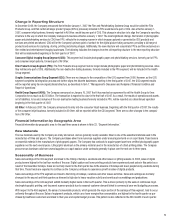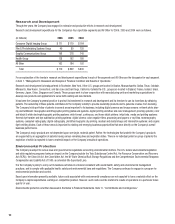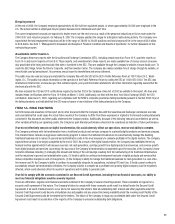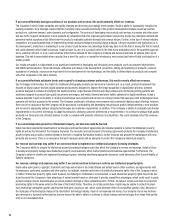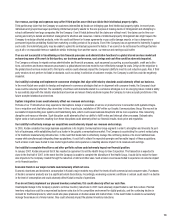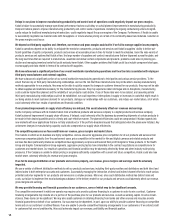Kodak 2006 Annual Report Download - page 14
Download and view the complete annual report
Please find page 14 of the 2006 Kodak annual report below. You can navigate through the pages in the report by either clicking on the pages listed below, or by using the keyword search tool below to find specific information within the annual report.
The distribution of motion pictures to theaters on print film is another important element of the business, one that the Company works hard to
preserve. Price competition is a bigger factor in this segment of the motion picture market, but the Company continues to maintain the leading share
position.
In the consumer and professional film markets, Kodak continues to maintain the leading worldwide share position despite continuing strong competi-
tion as the market declines. The exit of several smaller participants, along with the move of retailers to a 2-brand strategy, has enabled the Company
to secure a number of preferred contract renewals with leading retailers in Europe and North America, strengthening our position as the market
consolidates. In 2006, Kodak continued to offer selective innovation, upgrading our family of one-time-use cameras with improved film and introduc-
ing a new family of Kodak Professional Portra films, which won significant acclaim and industry awards. Price increases during 2006 led to the most
stable pricing in nearly a decade.
Declines in the market for color photographic papers moderated during 2006, led by increased demand for digital printing. The Company’s strategy
to capitalize on this trend is to offer a variety of color paper formulations designed to optimize digital printing workflows in consumer and professional
photo processing labs. The Company also offers to professional and commercial labs an industry-leading family of digital workflow software designed
to improve their workflows and enhance our position as a supplier of consumables. Kodak’s paper business also benefited from industry consolidation,
gaining volume as several smaller participants have left the market.
Traditional products and services for the consumer are sold direct to retailers and through distributors throughout the world. Price competition con-
tinues to exist in all marketplaces. To be more cost competitive with its traditional product offerings, the Company is continuing to rationalize capacity
and restructure its go-to-market model. As previously outlined, digital product offerings are substituting for some of the traditional film products, as a
large number of consumers actively use digital cameras. While this substitution to date has had an impact primarily on the Company’s film and paper
sales, and processing services in the U.S., Japan and Western Europe, there are declining sales in emerging markets as well.
Throughout the world, almost all Entertainment Imaging products are sold directly to studios, laboratories, independent filmmakers or production
companies. Quality and availability are important factors for these products, which are sold in a price competitive environment. As the industry moves
to digital formats, the Company anticipates that it will face new competitors, including some of its current customers and other electronics manufac-
turers.
Graphic Communications Group (GCG) Segment
Sales from continuing operations of the Graphic Communications Group segment for 2006, 2005 and 2004 were (in millions) $3,632, $2,990 and
$1,344, respectively.
The Graphic Communications Group segment serves a variety of customers in the creative, in-plant, data center, commercial printing, packaging,
newspaper and digital service bureau market segments with a range of software, media and hardware products that provide customers with a variety
of solutions for prepress equipment, workflow software, digital and traditional printing, document scanning and multi-vendor IT services. Products in-
clude digital and traditional prepress consumables, including plates, chemistry, and media; workflow and proofing software; color and black and white
electrophotographic equipment and consumables; high-speed, high-volume continuous inkjet printing systems; wide-format inkjet printers; high-
speed production document scanners; micrographic peripherals; and media (including micrographic films). The Company also provides maintenance
and professional services for Kodak and other manufacturers’ products, as well as providing imaging services to customers.
Marketing and Competition: Throughout the world, graphic communications products are sold through a variety of direct and indirect channels.
The end users of these products include businesses in the commercial printing, data center, in-plant and digital service provider market segments.
While there is price competition, the Company has been able to maintain price by adding more attractive features to its products through technologi-
cal advances. The Company has developed a wide-range portfolio of digital products; workflow, equipment, media, and services to meet the needs
of customers who are interested in converting from traditional analog to digital technology. Maintenance and professional services for the Company’s
products are sold either through product distribution channels or directly to the end users.
The growth in digital solutions has negatively affected the sale of traditional graphic films. As a result, the Company has become more active in digital
printing products and services in order to participate in this growth segment through the acquisitions of Scitex Digital Printing, renamed Kodak Versa-
mark, the NexPress-related entities, KPG and Creo. Traditional graphic products, primarily consisting of graphic films and chemistry, were formerly
sold directly by the Company to the KPG joint venture.
In addition, a range of inkjet products for digital printing and proofing are sold through direct and indirect means. Document scanners are sold primar-
ily through a two-tiered distribution channel to a number of different industries. The Company remains competitive by focusing on developing digital
solutions based on inkjet, thermal and electro-photographic technologies by comprehensive workflow, training and service systems.



